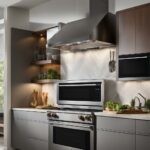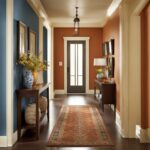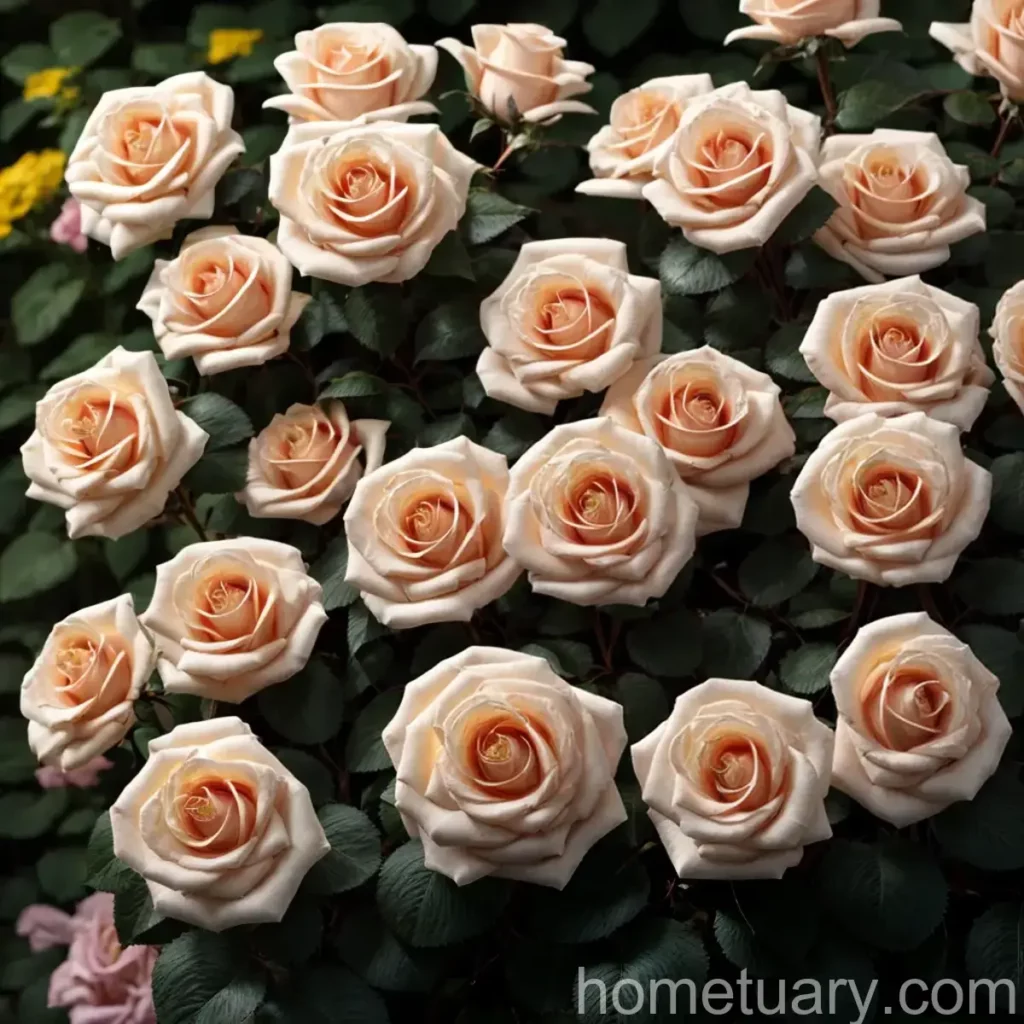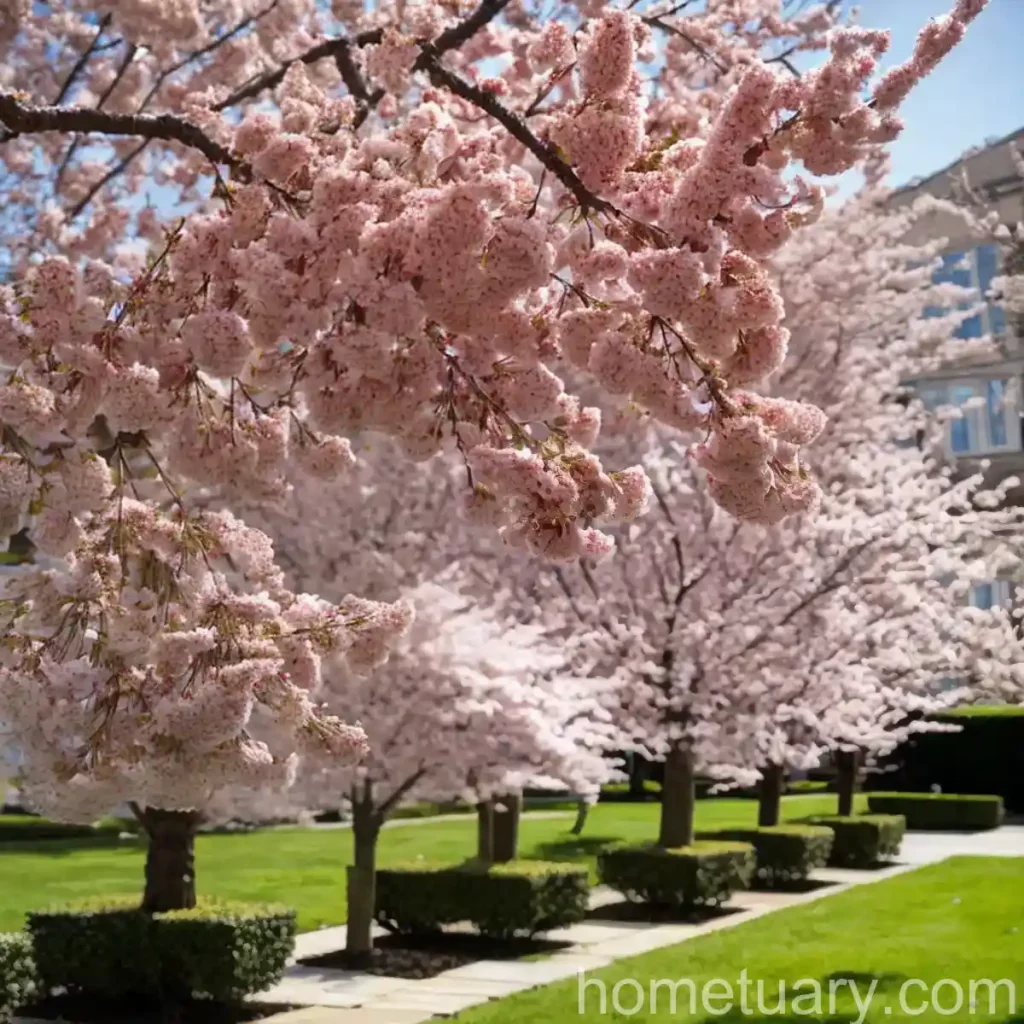The latest kitchen design trends for 2024 are redefining the balance between style and practicality. With a focus on eco-friendly materials, integrated smart technology, and multifunctional kitchen islands, homeowners have the opportunity to create a culinary haven that reflects their personal style. When it comes to lighting, the right temperature can make all the difference in creating a welcoming and functional space. In this article, I will explore the best light temperature for kitchens and provide top picks and fresh ideas to illuminate your culinary space.
Key Takeaways:
- Choosing the right light temperature is crucial for creating a welcoming and functional kitchen.
- Understanding the Kelvin scale helps in selecting the appropriate light temperature.
- There is a balance between warm and cool light in the kitchen to consider for different areas.
- LED lights offer a wide range of light temperature options.
- Personalizing your kitchen lighting design enhances the overall style and ambiance.
The Importance of Proper Light Temperature in the Kitchen
The light temperature in the kitchen plays a crucial role in both functionality and ambiance. Using the right light temperature can enhance the visibility of tasks such as food preparation and cooking, as well as create a warm and inviting atmosphere. Different light temperatures, measured in Kelvin (K), have varying effects on the appearance of colors and the overall mood of the space. Understanding the impact of light temperature is essential in choosing the best lighting options for your kitchen.
Proper light temperature is essential in the kitchen for several reasons. Firstly, it affects the visibility and clarity of tasks such as chopping vegetables or reading recipes. A cooler light temperature, similar to daylight, can provide a brighter and crisper illumination, allowing you to see the details more clearly. On the other hand, a warmer light temperature can create a softer and more relaxing ambiance, perfect for creating a cozy atmosphere during family dinners or evening gatherings.
In addition to functionality, light temperature also has a significant impact on the overall design and mood of the kitchen. Cooler light temperatures can make the space feel more modern, clean, and energizing, while warmer light temperatures can create a more traditional and inviting atmosphere. The choice of light temperature should align with your personal style and complement the overall design aesthetic of your kitchen.
Creating Ambiance with Light Temperature
One of the key benefits of proper light temperature in the kitchen is the ability to create ambiance. Light temperature can set the mood and tone of the space, whether you want a bright and lively kitchen for morning energy or a warm and cozy space for intimate dinners. By strategically selecting light fixtures with different temperatures, you can create layers of lighting that work together to create the desired ambiance.
| Light Temperature | Ambiance |
|---|---|
| Warm light (2700K – 3000K) | Creates a cozy and inviting atmosphere, perfect for relaxing or entertaining. |
| Cool light (3500K – 4500K) | Provides a bright and crisp illumination, ideal for task-oriented areas. |
| Daylight (5000K – 6500K) | Simulates natural daylight and creates a vibrant and energizing atmosphere. |
By mixing and matching different light temperatures in various areas of the kitchen, you can create a dynamic and visually appealing space. For example, combining warm light in the dining area and cool light in the work areas can provide both function and ambiance. It’s important to find the right balance that suits your needs and preferences, ensuring that your kitchen is not only well-lit but also a place where you feel comfortable and inspired.
Understanding the Kelvin Scale for Light Temperature
To choose the best light temperature for your kitchen, it is essential to understand the Kelvin scale. The Kelvin scale measures the color temperature of light, ranging from warm to cool. Warm light, typically ranging from 2700K to 3500K, emits a soft, yellowish glow that creates a cozy and inviting ambiance. Cool light, ranging from 5000K to 6500K, emits a brighter, bluish-white light that simulates daylight and provides a clean and energizing atmosphere.
The Color Rendering Index (CRI) is another factor to consider, as it measures the ability of a light source to accurately render colors. A higher CRI value indicates better color reproduction.
| Light Temperature | Color Appearance | Recommended Uses |
|---|---|---|
| 2700K – 3500K | Warm, yellowish glow | Dining areas, seating areas, creating a cozy ambiance |
| 5000K – 6500K | Bright, bluish-white light | Countertops, stovetops, task-oriented areas that require clarity and visibility |
By understanding the Kelvin scale and considering the desired mood and functionality of your kitchen, you can make informed decisions when choosing the light temperature that best suits your needs.
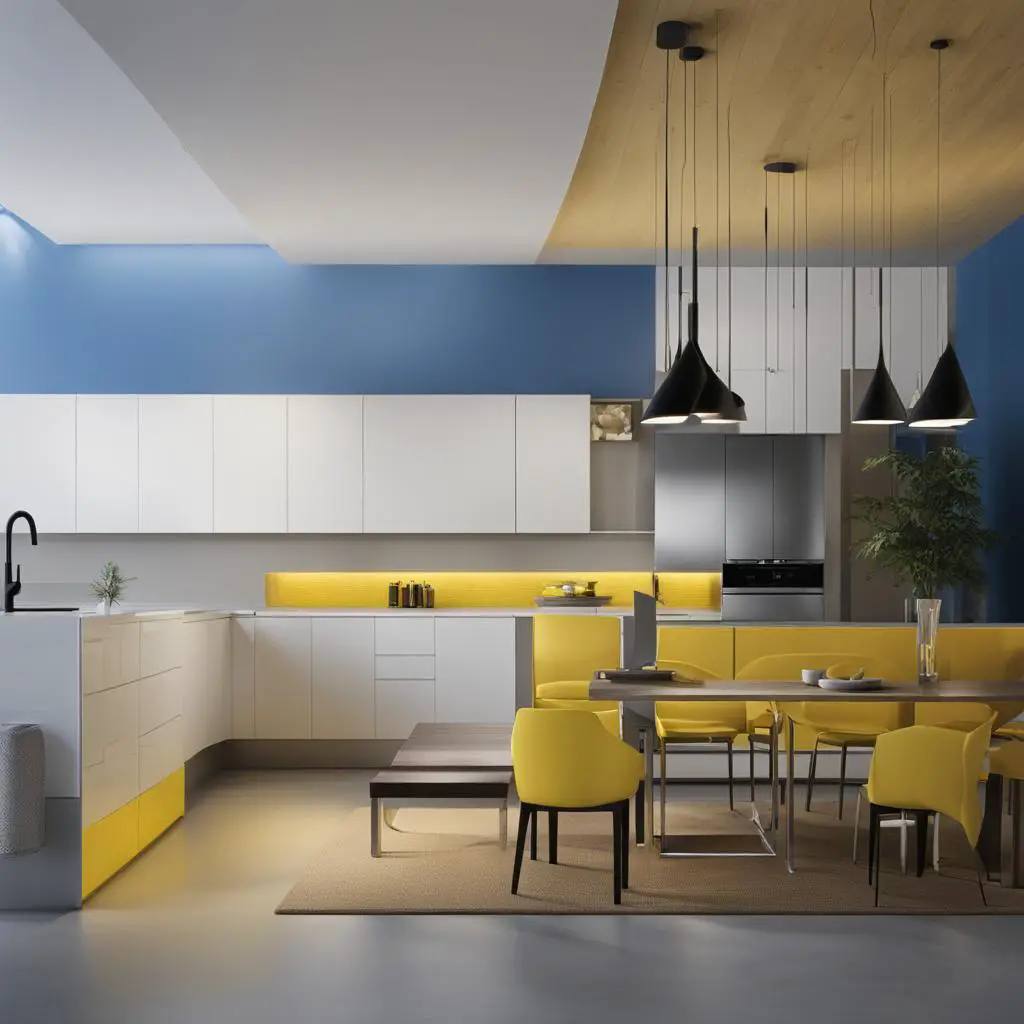
Finding the Right Balance: Warm vs. Cool Light in the Kitchen
When it comes to creating the perfect lighting scheme for your kitchen, finding the right balance between warm and cool light is essential. Warm light creates a cozy and inviting atmosphere, while cool light provides clarity and visibility for tasks. By mixing light temperatures throughout your kitchen, you can create a dynamic and visually appealing space that meets both functional and aesthetic needs.
To achieve a balanced lighting design, consider incorporating warm light in areas where a cozy ambiance is desired, such as dining or seating areas. This can be achieved using warm LED bulbs or warm-toned pendant lights. For task-oriented areas like countertops and stovetops, cool light is ideal to ensure proper visibility. Recessed lighting or under cabinet lighting with cool LED bulbs can effectively illuminate these areas.
Creating contrast with light temperature is also important to avoid a monotonous lighting scheme. By strategically placing warm and cool light sources throughout your kitchen, you can add depth and visual interest. For example, you can use warm accent lighting to highlight a decorative piece or cool track lighting to illuminate a functional area. The key is to experiment and find the right balance that suits your personal style and enhances the overall ambiance of your kitchen.
Examples of Mixing Light Temperatures in the Kitchen
“I love how the combination of warm pendant lights above my kitchen island and cool recessed lights over the countertops creates a beautiful contrast in my kitchen. It not only provides the perfect lighting for cooking but also adds a touch of sophistication to the overall design.”
By incorporating a mix of warm and cool light sources in your kitchen, you can achieve a balanced and visually appealing lighting design. Whether you prefer a cozy and intimate atmosphere or a bright and functional space, finding the right balance of light temperature will help you create the kitchen of your dreams.
| Warm Light | Cool Light |
|---|---|
| Creates a cozy and inviting atmosphere | Provides clarity and visibility for tasks |
| Perfect for dining or seating areas | Ideal for countertops and stovetops |
| Can be achieved with warm LED bulbs or pendant lights | Can be achieved with cool LED bulbs or recessed lighting |
| Highlights decorative elements | Emphasizes functional areas |
Recommended Light Temperature for Different Areas in the Kitchen
When it comes to lighting your kitchen, it’s important to consider the recommended light temperature for different areas. Each part of the kitchen serves a specific purpose, and the right light temperature can enhance functionality and aesthetics. Here are the recommended light temperatures for various kitchen areas:
Kitchen Areas
Task Lighting Temperature
| Area | Recommended Light Temperature |
|---|---|
| Countertops | 3500K to 4500K |
| Stovetops | 3500K to 4500K |
| Sinks | 3500K to 4500K |
Ambient Lighting Temperature
| Area | Recommended Light Temperature |
|---|---|
| Overall Kitchen Space | Blend of warm and cool light temperatures |
Accent Lighting Temperature
| Area | Recommended Light Temperature |
|---|---|
| Design Features or Objects | Varies based on desired effect |
By following these recommended light temperatures, you can ensure that each area of your kitchen is properly illuminated for its intended purpose. Task areas such as countertops and stovetops benefit from cool light temperatures, providing ample visibility and clarity for food preparation. For the overall kitchen space, a blend of warm and cool light temperatures creates a balanced and inviting ambiance. Accent lighting allows you to highlight specific design features or objects, and the light temperature can be adjusted to achieve the desired effect.
Popular Kitchen Lighting Options by Light Temperature
When it comes to kitchen lighting, choosing the right temperature can significantly impact the overall look and feel of your space. There are several popular kitchen lighting options available in different light temperatures, allowing you to customize your kitchen’s ambiance and functionality. Here are some top picks for kitchen lighting options based on light temperature:
Pendant Lights

Pendant lights are a popular choice for kitchens due to their versatility and aesthetic appeal. They come in various styles, shapes, and light temperatures, allowing you to find the perfect fit for your kitchen design. Whether you prefer warm, cozy lighting or bright, task-oriented lighting, pendant lights can provide the desired effect while adding a stylish touch to your space.
Recessed Lighting
Recessed lighting offers a sleek and minimalistic look, making it a popular choice for modern kitchens. With recessed lights, you can choose from a range of light temperatures to create the ideal atmosphere. Whether you want warm lighting for a relaxed ambiance or cool lighting for task-oriented areas, recessed lights can provide the versatility and functionality you need.
Track Lighting
Track lighting is a flexible lighting option that allows you to highlight specific areas in your kitchen. It consists of a track with adjustable light fixtures, making it easy to direct light where it’s needed the most. With track lighting, you can mix and match different light temperatures to create a dynamic and visually appealing lighting scheme in your kitchen.
Under Cabinet Lighting
Under cabinet lighting is a practical option for task lighting in the kitchen. It helps illuminate countertops and work areas, making food preparation and cooking easier. With under cabinet lighting, you can choose from warm or cool light temperatures, depending on your preference and the desired functionality of your kitchen.
Chandeliers
Chandeliers are not only a source of light but also a statement piece that adds elegance and style to your kitchen. They come in various styles and light temperatures, allowing you to create a focal point that complements your kitchen design. Whether you prefer warm and cozy lighting or bright and luxurious lighting, chandeliers can add a touch of sophistication to your space.
With these popular kitchen lighting options, you can find the perfect light temperature to enhance the functionality and aesthetics of your kitchen. Whether you prefer pendant lights, recessed lighting, track lighting, under cabinet lighting, or chandeliers, there are options available to suit your personal style and create the desired ambiance in your culinary haven.
Layered Lighting and Hidden Lighting for an Ambient Glow
To create a well-balanced and visually appealing kitchen lighting design, layered lighting is key. This involves using multiple light sources at different heights and intensities to create depth and dimension. By incorporating light sources with varying light temperatures, you can achieve a harmonious blend of warm and cool light throughout the space, adding depth and visual interest to your kitchen.
Hidden lighting, such as strip lights or tape lights, can be installed under cabinets or behind shelves to provide a subtle and ambient glow. This hidden lighting technique adds an extra layer of illumination, highlighting architectural features and creating a sense of depth within the kitchen. It also adds a touch of sophistication and elegance to the overall design.
By strategically placing different light sources and layering the light throughout the kitchen, you can create a truly immersive and ambient space. The combination of warm and cool light, along with hidden lighting techniques, adds depth and visual interest, making your kitchen a welcoming and inviting environment for cooking and entertaining.
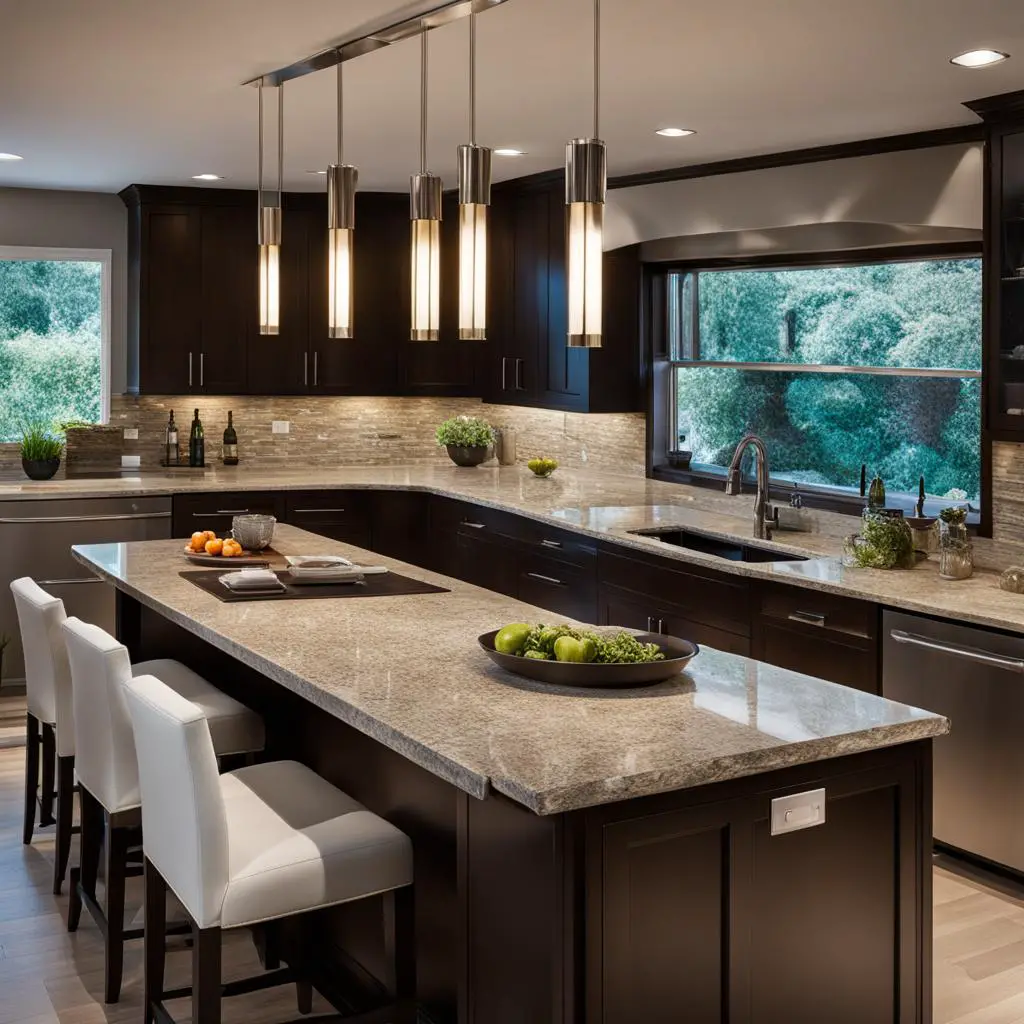
Table: Layered Lighting Tips
| Layer | Lighting Type | Light Temperature |
|---|---|---|
| Ambient | Recessed lighting | 3000K |
| Task | Pendant lights | 4000K |
| Accent | Under cabinet lighting | 2700K |
| Hidden | Tape lights | 3500K |
Table: Layered Lighting Tips
- Use recessed lighting as the main source of ambient light, with a light temperature of 3000K, to provide overall illumination to the kitchen space.
- Add pendant lights above the kitchen island or dining area as task lighting, with a light temperature of 4000K, to provide focused light for food preparation and dining.
- Incorporate under cabinet lighting as accent lighting, with a light temperature of 2700K, to highlight specific areas or objects in the kitchen, such as backsplashes or display shelves.
- Enhance the ambiance and add depth by installing hidden lighting, such as tape lights, under cabinets or behind shelves. Choose a light temperature of 3500K for a subtle and warm glow.
Layered lighting adds depth and creates a warm and inviting atmosphere in the kitchen. By using multiple light sources at different heights and intensities, along with hidden lighting techniques, you can achieve a visually stunning and functional lighting design.
Sculptural Light Fixtures for a Statement Look
When it comes to kitchen lighting, why settle for ordinary when you can make a statement? Sculptural light fixtures are the perfect way to add a touch of artistry and sophistication to your culinary space. These unique fixtures not only provide functional lighting but also serve as works of art themselves, elevating the overall aesthetic of your kitchen.
With their unconventional shapes and eye-catching designs, sculptural light fixtures become the focal point of any kitchen. Whether you opt for a modern pendant light with geometric patterns or a chandelier with intricate details, these fixtures bring a touch of elegance and personality to your kitchen.
By incorporating sculptural light fixtures with different light temperatures, you can further enhance their visual impact. A warm light temperature can create a cozy and inviting atmosphere, while a cool light temperature adds a contemporary and refreshing touch. Play with the contrast between warm and cool light to create a truly captivating lighting design that complements your personal style.
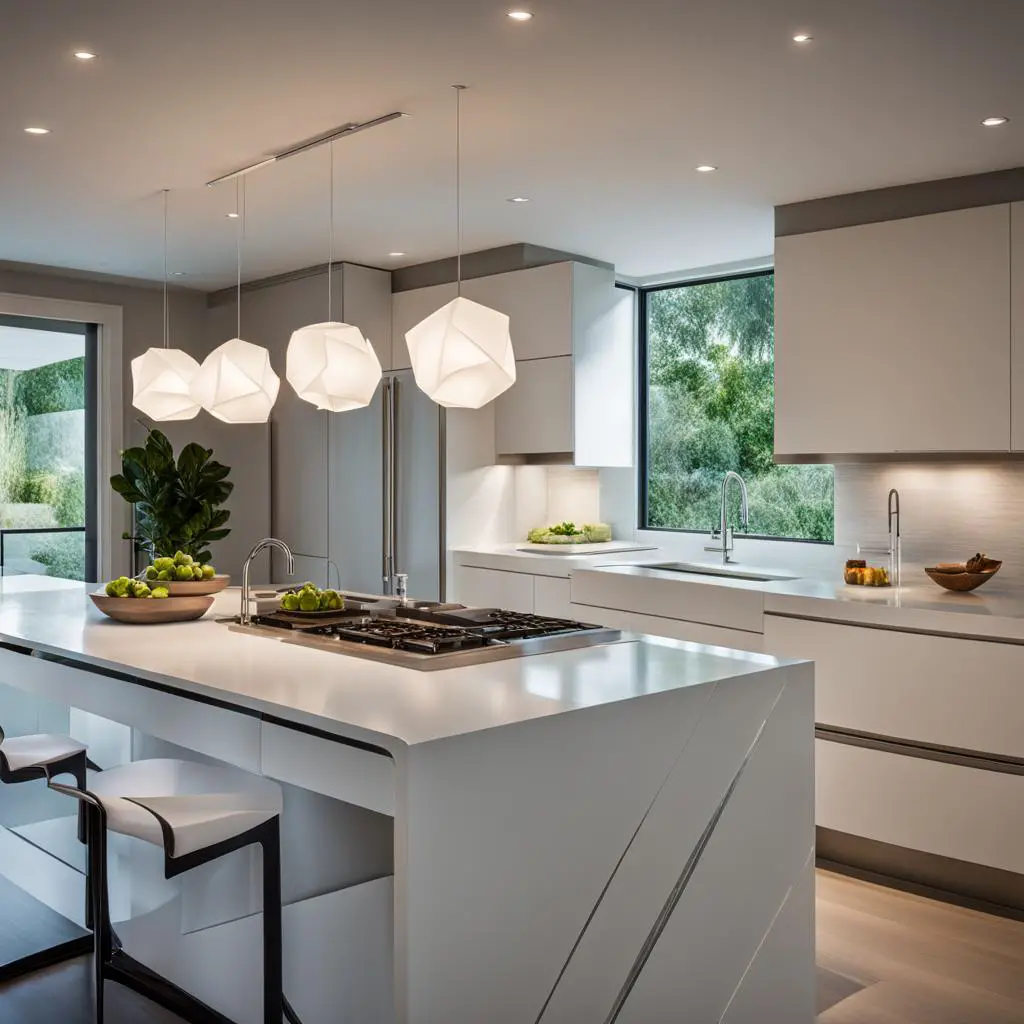
Unleash Your Creativity
When it comes to sculptural light fixtures, the possibilities are endless. You can find unique designs made from various materials such as metal, glass, or even repurposed items. Mix and match different shapes and sizes to create a visually dynamic composition that reflects your artistic taste.
Consider incorporating multiple sculptural light fixtures throughout your kitchen to add depth and dimension. Install them above your kitchen island, dining area, or even as a statement piece above your sink. The right placement can enhance the overall balance and atmosphere of your kitchen.
“Sculptural light fixtures are an excellent way to add personality and style to your kitchen. They not only illuminate the space but also serve as stunning art pieces that make a statement. Choose a design that resonates with your aesthetic and complements the overall theme of your kitchen.”
When it comes to kitchen lighting, don’t be afraid to think outside the box and let your creativity shine. Sculptural light fixtures offer a unique opportunity to transform your culinary haven into a truly remarkable space. Let your personal style guide your choices and create a lighting design that is as individual as you are.
Smart and Adaptive Lighting for Convenience and Energy Efficiency
I believe that incorporating smart and adaptive lighting systems in your kitchen can greatly enhance convenience and energy efficiency. These innovative lighting solutions utilize advanced technology to provide seamless control and automation, making your kitchen lighting experience effortless and efficient.
One popular feature of smart lighting is motion sensor technology. With motion sensor lighting, your kitchen lights can automatically turn on or off as you enter or leave the room. This not only eliminates the need to manually switch lights on and off, but it also helps conserve energy by ensuring that lights are only in use when needed.
Another useful feature of smart lighting is programmable lighting. With this feature, you can set specific light levels and schedules for your kitchen. For example, you can program your lights to gradually brighten in the morning to help you wake up, or dim in the evening to create a relaxing ambiance for dinner. This level of customization allows you to tailor the lighting in your kitchen to match your daily routines and preferences.
Furthermore, voice-controlled lighting systems, compatible with virtual assistants like Alexa or Google Assistant, provide a hands-free and convenient way to control your kitchen lights. With simple voice commands, you can adjust the light temperature, dim or brighten the lights, or even change the color of your smart LED bulbs. This technology adds a modern and futuristic touch to your kitchen, while also offering enhanced accessibility and ease of use.
“Smart lighting systems offer convenience, energy efficiency, and customization for your kitchen lighting.”
Benefits of Smart and Adaptive Lighting:
- Convenience: Motion sensor lighting ensures that lights are only on when needed, eliminating the need for manual operation.
- Energy Efficiency: Smart lighting allows for precise control over light levels and schedules, reducing energy consumption.
- Customization: Programmable lighting allows you to personalize your kitchen lighting to match your daily routines and preferences.
- Voice Control: Voice-controlled lighting systems provide hands-free operation and easy access to adjusting the lights.
Metallic and Gold Lights for a Touch of Glamour
When it comes to creating a luxurious and glamorous kitchen, the right lighting can make all the difference. Metallic and gold light fixtures are the perfect choice to add a touch of opulence and sophistication to your culinary space. These trendy fixtures come in various styles and shapes, allowing you to customize the look and feel of your kitchen.
Whether you opt for sleek metallic pendant lights or dazzling gold chandeliers, these fixtures serve as more than just a source of light. They become statement pieces that elevate the overall aesthetic of your kitchen, creating a visually stunning focal point. The metallic and gold finishes reflect light in unique ways, adding a warm and inviting glow to the space.
“The right lighting can transform an ordinary kitchen into a glamorous culinary haven, and metallic and gold light fixtures are the epitome of luxury and style.”
Pairing metallic and gold light fixtures with warm light temperature further enhances the overall ambiance of your kitchen. The combination of the radiant glow and the elegant fixtures creates a cozy and intimate atmosphere, perfect for hosting gatherings or enjoying a romantic dinner. Your kitchen will become a space that exudes sophistication and sets the stage for culinary adventures.
| Fixture Type | Description |
|---|---|
| Metallic Pendant Lights | Contemporary and sleek light fixtures with metallic finishes that hang from the ceiling, providing focused illumination and adding a touch of modern elegance to your kitchen. |
| Gold Chandeliers | Elaborate and ornate light fixtures with gold finishes that hang from the ceiling, making a grand statement and infusing your kitchen with a sense of luxury. |
| Metallic Wall Sconces | Wall-mounted light fixtures with metallic finishes that add a subtle touch of glamour and provide a soft and warm glow to enhance the ambiance of your kitchen. |
| Gold Track Lighting | Adjustable and versatile light fixtures with gold finishes that can be positioned to highlight specific areas or objects in your kitchen, creating a focal point and adding drama. |
With metallic and gold light fixtures, you can transform your kitchen into a luxurious haven that embodies your personal style. The combination of these trendy fixtures with warm light temperature creates a glamorous atmosphere that is sure to impress both guests and family members. Let your kitchen shine with the allure of metallic and gold lighting.
Top Picks for LED Light Temperature in the Kitchen
LED lights offer a wide range of light temperature options, making them a popular choice for kitchen lighting. When it comes to LED light temperature in the kitchen, it’s important to consider the desired ambiance and functionality of the space. Here are some top picks for different LED light temperatures:
Warm LED Lights (2700K to 3000K)
Warm LED lights emit a cozy and inviting glow, perfect for creating a warm and intimate atmosphere in the kitchen. These light temperatures are ideal for traditional or rustic kitchen designs, adding a touch of warmth and comfort. Warm LED lights can enhance the natural tones of wooden cabinets and countertops, creating a harmonious and inviting space.
Cool LED Lights (4000K to 5000K)
Cool LED lights provide a bright and crisp light, perfect for task-oriented areas in the kitchen. These light temperatures are ideal for modern and minimalist kitchen designs that focus on clean lines and functionality. Cool LED lights can make white surfaces appear even brighter, creating a fresh and energizing atmosphere that is perfect for food preparation and cooking.
Daylight LED Lights (5000K to 6500K)
Daylight LED lights simulate natural daylight and provide a vibrant and energizing atmosphere in the kitchen. These light temperatures are ideal for brightening up the space and creating a fresh and clean look. Daylight LED lights are perfect for kitchens with ample natural light, as they can seamlessly blend with the sunlight, creating a cohesive and bright environment.
Choosing the best LED light temperature for your kitchen depends on your personal preference and the desired mood of the space. Whether you prefer a warm and cozy atmosphere or a bright and crisp look, LED lights offer a variety of options to suit your needs. Experiment with different light temperatures to create a lighting design that enhances the functionality and style of your culinary haven.
Fresh Ideas for Illuminating Your Culinary Haven
When it comes to kitchen lighting, there are numerous innovative and creative ideas that can transform your culinary haven into a visually stunning and functional space. Whether you’re looking to add a touch of glamour, incorporate unique designs, or explore unconventional lighting solutions, there is no shortage of fresh ideas to inspire you. Here are some innovative kitchen lighting ideas to consider:
1. Statement Pendant Lights
Add a stylish and eye-catching focal point to your kitchen by installing statement pendant lights. Opt for unique designs or unconventional shapes that complement the overall aesthetic of your space. From geometric fixtures to bold colors, pendant lights can add a touch of personality and style to your kitchen.
2. Backlit Glass Cabinets
Create a stunning visual effect by incorporating backlit glass cabinets in your kitchen. Install LED strip lights behind glass cabinet doors to highlight and illuminate your glassware and dishware. This not only adds a touch of elegance but also creates a beautiful display that showcases your culinary collection.
3. Colorful LED Strips
Add a pop of color and personality to your kitchen by using colorful LED strips. Install these strips under cabinets, along the edges of countertops, or even behind open shelving to create a vibrant and dynamic lighting scheme. With a wide range of colors to choose from, you can create a truly unique and personalized lighting design.
4. Task Lighting with Adjustable Fixtures
For optimal task lighting in your kitchen, consider installing adjustable fixtures that can be directed towards specific areas. This allows you to focus the light where it’s needed most, such as countertops or stovetops, ensuring clear visibility and functionality during food preparation and cooking.
| Idea | Description |
|---|---|
| Statement Pendant Lights | Add a stylish and eye-catching focal point to your kitchen with unique and unconventional pendant lights. |
| Backlit Glass Cabinets | Create a stunning visual effect by incorporating backlit glass cabinets to showcase your glassware and dishware. |
| Colorful LED Strips | Add a pop of color and personality to your kitchen with vibrant and dynamic LED strips. |
| Task Lighting with Adjustable Fixtures | Install adjustable fixtures to provide focused task lighting on specific areas, such as countertops and stovetops. |
With these fresh ideas and innovative designs, you can transform your kitchen into a visually striking and functional space. Whether you choose to incorporate statement pendant lights, backlit glass cabinets, colorful LED strips, or adjustable task lighting fixtures, the key is to personalize your lighting design to reflect your unique style and create a truly one-of-a-kind culinary haven.
Choosing the Right Light Temperature for Your Personal Style
When it comes to selecting the light temperature for your kitchen, it’s essential to consider your personal style and how it aligns with the overall design of the space. The light temperature you choose can have a significant impact on the ambiance and mood of your kitchen, so it’s important to select one that complements your desired aesthetic. Whether you prefer a warm and cozy atmosphere or a modern and minimalist look, matching the light temperature with your kitchen design is crucial.
To create a cohesive lighting design, you can start by assessing the overall style of your kitchen. Traditional or rustic kitchens often benefit from warm light temperatures, ranging from 2700K to 3000K, which create a welcoming and intimate atmosphere. On the other hand, modern and minimalist kitchens can be enhanced with cool light temperatures, typically ranging from 4000K to 5000K, that emphasize clean lines and simplicity.
Personalizing your kitchen lighting goes beyond simply choosing the light temperature. You can also incorporate various lighting fixtures and techniques that reflect your unique style. Consider using pendant lights or chandeliers in designs that complement your kitchen’s aesthetic. Experiment with different light temperatures and fixture styles to create a truly personalized lighting scheme that brings out the best in your kitchen design.
Creating a Cohesive Lighting Design
A well-designed lighting scheme should not only provide adequate illumination but also create a cohesive and visually pleasing look. To achieve this, it’s essential to consider the different areas in your kitchen and how the light temperature can enhance their functionality and ambiance. Task-oriented areas such as countertops and stovetops may benefit from cooler light temperatures to ensure clarity and visibility. In contrast, dining or seating areas can be enhanced with warmer light temperatures to create a cozy and inviting atmosphere.
By layering different light sources with varying light temperatures, you can create depth and visual interest in your kitchen. Use hidden lighting, such as strip lights or tape lights, to provide a subtle ambient glow and highlight certain design features. Incorporating accent lighting with focused beams can also draw attention to specific areas or objects, adding a touch of drama to your kitchen. The key is to strike a balance between warm and cool light sources to create a cohesive and harmonious lighting design that complements your personal style.
| Personal Style | Recommended Light Temperature |
|---|---|
| Traditional or rustic | 2700K to 3000K (Warm light) |
| Modern and minimalist | 4000K to 5000K (Cool light) |
The Impact of Light Temperature on Health and Well-Being
When it comes to lighting our kitchens, we often focus on aesthetics and functionality. However, the light temperature in our kitchens can also have a significant impact on our health and well-being. Exposure to certain light temperatures can affect our circadian rhythm, disrupt our sleep patterns, and even influence our hormone production.
One of the key factors to consider is the blue light exposure from cool light temperatures. Cool light, which is often associated with higher levels of blue light, can interfere with our natural sleep-wake cycle. It suppresses the production of melatonin, a hormone that regulates sleep, making it harder to fall asleep and stay asleep. By opting for warmer light temperatures in the evening and during nighttime hours, we can promote relaxation and facilitate a better night’s sleep.
Our circadian rhythm, also known as our internal body clock, plays a crucial role in regulating our sleep-wake cycle and various physiological processes. Exposure to the right light temperature at the right time of day can help synchronize our circadian rhythm and promote overall well-being. For example, exposure to bright, cool light in the morning can help us feel more awake and energized, while warmer light in the evening promotes relaxation and prepares our bodies for restful sleep.
“The right light temperature in our kitchens can contribute to a healthier and more balanced lifestyle.”
By choosing the right light temperature for our kitchens, we can create a space that not only looks beautiful but also promotes our health and well-being. Opting for warm light in the evening and cooler light in the morning can help regulate our circadian rhythm and optimize our sleep patterns. So, when designing your kitchen lighting, consider the impact of light temperature on your health and make choices that support your overall well-being.
| Light Temperature | Effects on Health |
|---|---|
| Warm Light (2700K-3500K) | Promotes relaxation, facilitates better sleep, and supports a healthy sleep-wake cycle. |
| Cool Light (5000K-6500K) | Boosts energy and alertness, enhances focus and productivity. |
| Blue Light (5000K-6500K) | Can disrupt sleep patterns, suppresses melatonin production, and affects circadian rhythm. |
Summary:
- The light temperature in our kitchens can impact our health and well-being.
- Exposure to cool light with high levels of blue light can disrupt our sleep patterns and circadian rhythm.
- Warm light promotes relaxation and facilitates better sleep.
- Choosing the right light temperature in our kitchens can contribute to a healthier and more balanced lifestyle.
Conclusion
In conclusion, choosing the right light temperature for your kitchen is essential to create a welcoming and functional space. By understanding the Kelvin scale and the impact of warm and cool light, you can make informed decisions when selecting lighting options for your kitchen. Whether you prefer a cozy and intimate atmosphere or a bright and energizing ambiance, there are light temperature options to suit your personal style.
It’s important to create a balance between warm and cool light throughout your kitchen to avoid a monotonous lighting scheme. By strategically blending light temperatures and using a layered approach to lighting, you can achieve a visually appealing and dynamic kitchen design.
Don’t be afraid to get creative with your kitchen lighting. There are plenty of innovative ideas and unique designs that can add a personalized touch to your space. From sculptural light fixtures to hidden lighting and smart systems, the possibilities are endless.
Remember, the right light temperature not only enhances the aesthetics of your kitchen but also has an impact on your health and well-being. Consider the effects of light on your sleep patterns and melatonin production when choosing the light temperature for your kitchen. The goal is to create a space that promotes relaxation and a sense of well-being.
FAQ
What is the importance of proper light temperature in the kitchen?
The light temperature in the kitchen plays a crucial role in both functionality and ambiance. It enhances visibility for tasks and creates a warm and inviting atmosphere.
How can I choose the best light temperature for my kitchen?
To choose the best light temperature for your kitchen, it is essential to understand the Kelvin scale. Warm light (2700K to 3500K) creates a cozy ambiance, while cool light (5000K to 6500K) provides a bright, energizing atmosphere. Consider the desired mood and functionality of each area in your kitchen.
What are some popular kitchen lighting options by light temperature?
LED lights offer a wide range of options. Pendant lights, recessed lighting, track lighting, under cabinet lighting, and chandeliers are all popular choices. Each can be customized to different light temperatures.
How can I create a well-balanced lighting design in my kitchen?
Layered lighting is key. Use multiple light sources at different heights and intensities to create depth and dimension. Hidden lighting, such as strip lights or tape lights, can provide a subtle and ambient glow.
What are some fresh ideas for illuminating my kitchen?
Consider installing lighting within shelves and cabinets, incorporating backlighting behind a textured backsplash, or using repurposed materials for pendant lights. Get creative to make your kitchen lighting design unique.
How does light temperature impact health and well-being?
Exposure to cool light with high levels of blue light can disrupt your sleep patterns. Warm light promotes relaxation and can help regulate melatonin production, leading to better sleep.
How can I personalize my kitchen lighting design?
Consider your personal style and the overall design of your kitchen. Match the light temperature with the design elements to create a cohesive and visually pleasing lighting design.


